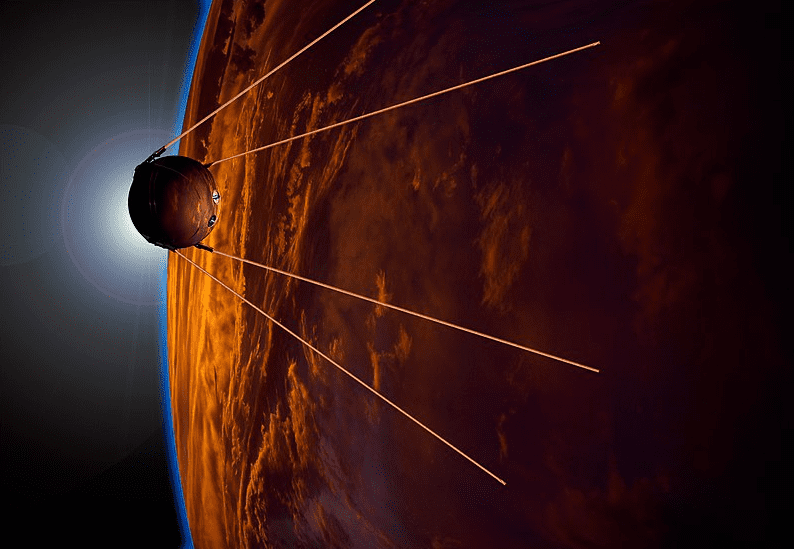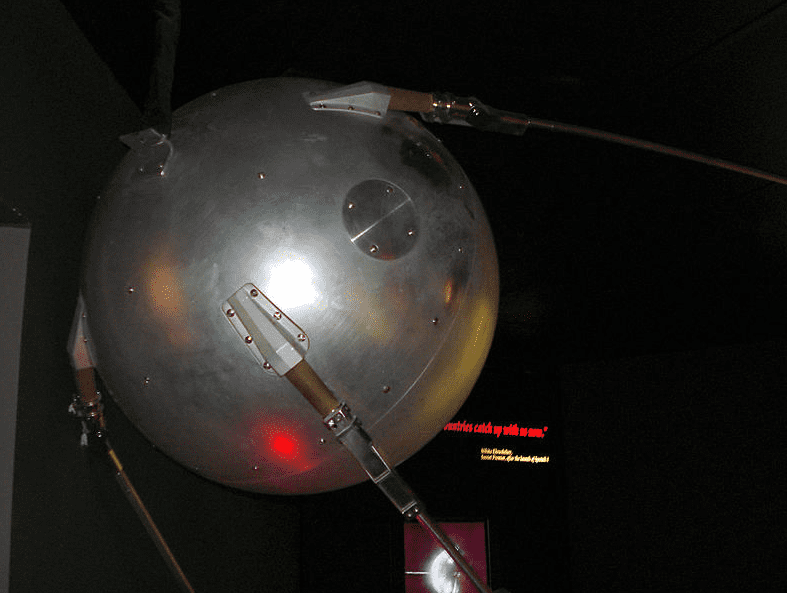It was just a small metal sphere about the size of a beach ball, only 23 inches in diameter. When the Soviet Union launched the Sputnik 1 satellite into orbit on 4 October 1957, however, it slammed into the U.S. psyche like a huge wrecking ball. Suddenly America’s position as the world’s preeminent scientific nation, and even the success of its capitalist system, was being called into question by a communist country with scientific goals of its own.

The space race had begun – the dawn of a new era in scientific and technological achievement.
The Sputnik launch occurred during what was supposed to be a year of international scientific collaboration called the International Geophysical Year (IGY), designated by the International Council of Scientific Unions to run from 1 July 1957 to 31 December 1958. Both the U.S. and the U.S.S.R. announced they would launch artificial satellites during the IGY. As the nation that invented the atomic bomb, the Americans’ superior technology and advanced scientific knowledge made them the frontrunner for the honor of launching the first satellite. But the Russians beat them to it.
The U.S. was moving right ahead with its satellite project, called Vanguard. It planned to launch some small 6.4-inch balls into orbit in November, and launch a real satellite in early spring 1958. The launch of Sputnik caught the U.S. scientists completely by surprise. Not only were they unaware the Russians had that much capability, the size of Sputnik astonished them. The planned U.S. satellite was only about 22 pounds – the Russians successfully launched a 185-pound satellite!
In today’s age of hundreds of satellites constantly circling overhead, it is hard to imagine the apprehension and outright fear that gripped Americans at the thought that high overhead in space, out of their government’s reach and control, a rival nation had placed a spacecraft that was orbiting above the United States. The military implications of such a potential threat were obvious.
The American public’s sense of vulnerability was heightened by the fact that Sputnik’s radio transmitter emitted a beep that amateur radio operators could easily pick up – and millions of Americans listened in wonder and fear as this Russian satellite kept circling over the U.S. In addition, Sputnik could easily be seen with a simple pair of binoculars, making its presence, and its threat, seem all the more real.

For the Americans, the launch of Sputnik was like poking a stick into a hornets’ nest – there was suddenly a great buzz of concern and frenetic activity. The U.S. Defense Department quickly funded a second American satellite project, Explorer, and accelerated its schedule. Before the new project could restore American prestige, however, the Soviet Union scored another coup by successfully launching its second satellite, Sputnik II, on November 3 – a much bigger satellite (1,120 pounds) that carried a dog into space.
The U.S. finally asserted itself in the new space race by launching its first satellite, Explorer I, on 31 January 1958. To accelerate its space program, the U.S. created the National Aeronautics and Space Administration (NASA) on 1 October 1958.
The Soviet Union kept achieving other firsts, however, such as the first man in space, the first woman, the first space walk, and the first space craft to land on the moon. Finally, American superiority in the space race was achieved, and emphatically demonstrated, on 20 July 1969, when the Apollo 11 space mission successfully landed the first humans on the moon.
The following newspaper article gives an indication of how the American public learned of the Russians’ success with Sputnik. In the main headline, Americans are warned that Sputnik is “Circling Us 15 Times a Day.” The article points out that with Sputnik, “the Soviet Union claimed a victory over the United States.”
The article relays the official announcement from Moscow praising Sputnik’s scientific contribution to humankind:
“The successful launching of the first man-made satellite makes a tremendous contribution to the treasure house of world science and culture.”
Moscow’s announcement was not limited to the scientific realm, however. The Soviets could not resist the propaganda opportunity of a little gloating over their capitalist rivals, which the newspaper article was careful to reprint as well:
“Artificial earth satellites will pave the way for space travel and it seems that the present generation will witness how the freed and conscious labor of the people of the new socialist society turns even the most daring of man’s dreams into reality…”

Here is a transcription of this article:
SATELLITE FIRED BY RUSSIA;
CIRCLING US 15 TIMES A DAY
U.S. Tracks It in Space Orbit 560 Miles Out
185-Pound ‘Moon’ Visible with Glasses, Moscow Says in Claiming IGY Victory; Launched by Rocket; Radio Signals Heard
By Harold K. Milks
MOSCOW, Saturday, Oct. 5 (AP) – The Soviet Union announced today it has the world’s first artificial moon streaking around the globe 560 miles out in space.
A multiple-stage rocket launched the earth satellite yesterday, the Russians said, shooting it upward at about five miles per second.
They said the satellite, a globe described as 23 inches in diameter and weighing 185 pounds, can be seen in its orbit with glasses and followed by radio through instruments it carries.
In thus announcing the launching of the first earth satellite ever put in globe-girdling orbit under man’s controls, the Soviet Union claimed a victory over the United States.
The two big powers had been in a hot, but mainly secret, race to be first to probe the high space realms with spheres laden with instruments.
Tracked by U.S.
(In Washington the Defense Department said Friday night the naval research laboratory there had recorded three passes of the satellite over the United States.
(The department said the laboratory, with its radio tracking equipment, reported one pass seemed to be in the vicinity of Washington and two further west.
(The laboratory will continue its tracking in an attempt to derive some scientific information, the department said.)
The Moscow announcement said:
“The successful launching of the first man-made satellite makes a tremendous contribution to the treasure house of world science and culture.
“Artificial earth satellites will pave the way for space travel and it seems that the present generation will witness how the freed and conscious labor of the people of the new socialist society turns even the most daring of man’s dreams into reality…”
In a special bulletin early this morning, the Soviet Tass agency said the Russian moon “is now revolving around the earth at the rate of one circuit every hour and 35 minutes.”
The launching occurred just three months and four days after the opening of the International Geophysical Year.
Moscow reported the satellite can be seen with the simplest kind of telescope glasses. Its velocity was given as something like five miles per second at a height of about 560 miles above the earth.
The broadcast said the Russians plan to launch several more earth satellites in the next year. It declared the developments will open a way for travel to the planets.
Moscow said the satellite is fitted with steel radio transmitters continuously sending signals earthward on the 15 and 7.5 meter wave lengths and easily received by a broad range of amateur sets. Its announced weight of about 185 pounds is more than eight times the weight of a projected U.S. earth satellite.
Moscow described the signals as of about 3/10 of a second long with a pause of the same length. The two frequencies alternate in signaling, Moscow Radio said.
It announced the first satellite would appear over the Moscow area twice Saturday morning. It did not give other sighting points on the course.
Bigger Ones Planned
The broadcast said Soviet satellites planned later will be bigger and heavier than the first sphere.
U.S. experts in Washington were amazed at the reported size of the Soviet moon. Dr. Joseph Kaplan, chairman of the U.S. national committee for the International Geophysical Year (IGY) said its 185-pound weight and 23-inch span “is really fantastic. If they can launch that, they can launch much heavier ones.”
The U.S. experts figured the first U.S. launching attempt would be made early next spring after an attempt to put some 6.4 inch, 4-pound objects into the earth’s orbit for a short time in November.
Russia had been silent on the progress of its experiments since last June 19 when a news conference in Moscow was told Russian scientists planned to launch one or more satellites during the IGY that began July 1.
U.S. spokesmen said last May the United States did not plan a secret launching and hoped the Russians didn’t either. But U.S. officials were quick to congratulate the Russians on the announced feat.
Might Burn Up
The Moscow broadcast said Soviet scientific stations were still trying to determine the flying sphere’s exact trajectory. It said that because the density of the rarefied upper layers is not accurately known there are no data to determine the points of the satellite’s entry into the denser strata.
The broadcast added, however, that its tremendous velocity will cause the satellite to burn up on reaching the denser layers.
United States scientists were reported in July as planning to launch some tiny satellites early in November as a test prelude to the later projected launching next spring of a larger sized “baby moon.”
It was said at the time that one or more of these smaller objects might get into an orbit around the earth, though for a very short time. The little ones would be only 6.4 inches in diameter and weigh only four pounds, compared with the 22 pounds the larger satellite is expected to weigh.
Dr. John P. Hagen, director of the American “Project Vanguard” satellite project, early this week told a conference of satellite scientists in Washington:
“Following the launching of four test spheres, the Navy will then attempt to launch and place in orbit the first 20-inch satellite.
“If our present test program continues on schedule, the first satellite launching attempt will be made early next spring.”
The Moscow broadcast quoted the official Tass news agency as saying:
“For several years research and experimental designing work has been under way in the Soviet Union to create artificial satellites of the earth.
“It has already been reported in the press that the launching of the earth satellites in the U.S.S.R. was planned in accordance with the program of the International Geophysical Year research.
“As a result of the intensive work by research institutes and designing bureaus the first artificial earth satellite in the world has now been created.
“This first satellite was successfully launched in the U.S.S.R. on Oct. 4.”
“Elliptical Trajectory”
The broadcast said the satellite is revolving around the earth now on an elliptical trajectory at an estimated height of 900 kilometers (about 560 miles).
Moscow Radio described the satellite as “in the form of a sphere 58 centimeters (about 23 inches) in diameter, weighs 83.6 kilograms (about 185 pounds) and carries a radio transmitter.”
The Moscow broadcast went on:
“According to preliminary information the carrier rocket has imparted to the satellite the required orbital velocity of about 8,000 meters (about 26,246 feet) a second.
“At the present time the satellite is describing elliptical trajectories around the earth.
“Its flight will be observed in the rays of the rising and setting sun with the aid of the simplest optical instruments such as binoculars and spy glasses.”
Related Article:
